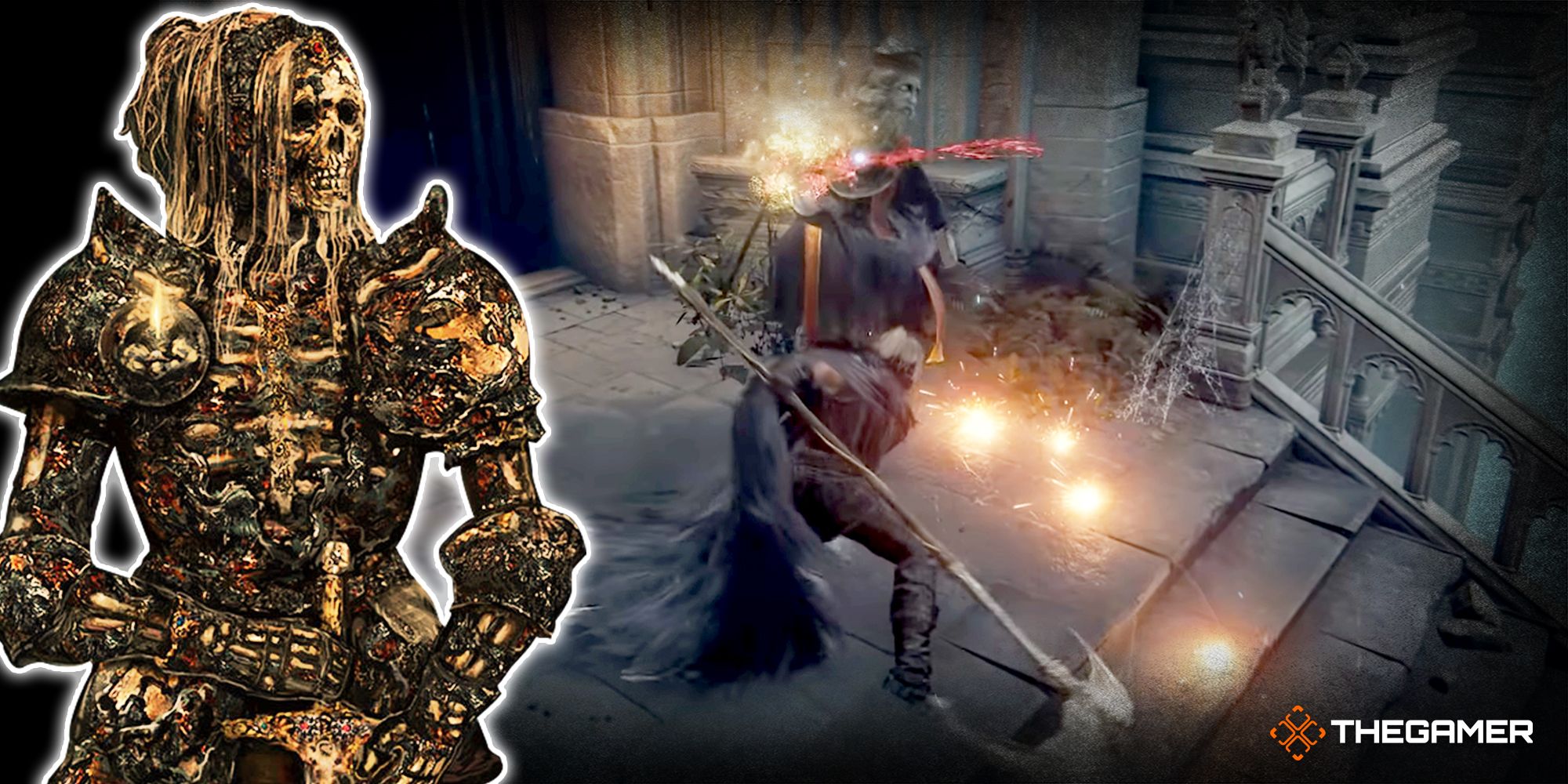
Quick Links
- Choosing Your Class And Keepsake
- Stat Building
- First Weapon: Winged Scythe
- Godslayer's Seal And Black Flame Incantations
- Second Weapon: Grave Scythe
- Alternative Weapons
- Armor Options
- Talisman Choices
- Wondrous Physick Suggestions
There is a playstyle for every Tarnished in Elden Ring's Lands Between. There is no right answer when it comes to the path you take toward becoming Elden Lord, but some paths may be easier to tread than others. Among those easier paths is one accessible in the early game and perfectly reasonable to stick with all the way to the very end: the Black Flame Reaper.
RELATED: Elden Ring Build Guide: Faith/Dexterity
The Black Flame Reaper is a specialized Faith-Dex Build that is flexible enough to allow for two unique playstyles and boasts great versatility in its support and offensive capabilities without needing a high level of skill to master. For this build, you’ll primarily focus on using scythes, casting black flame incantations, and having a backup weapon on hand for those tricky enemies that resist your primary damage types (holy, fire, slashing, and bleeding).
Choosing Your Class And Keepsake
There are ten available classes to choose from at the start of your game. Of those classes, it is recommended for this build and those of low experience with Elden Ring to begin with the Confessor.
Confessor Starting Stats
Stats
Vigor
10
Mind
13
Endurance
10
Strength
12
Dexterity
12
Gear
Weapons
Broadsword, Finger Seal
Armor
Confessor set, Blue Crest Heater Shield
Incantations
Urgent Heal, Assassin's Approach
read moreThe Confessor is recommended on three primary principles:
- It has the highest starting level of the group, lowering customizability but heightening your starting edge.
- It has the second-highest Faith stat and reliable Str and Dex.
- It starts with a seal that allows for incantation casting from day one.
Although the Prophet also is a decent choice, it suffers from needing more level-ups to reach the bare minimum requirements for the first scythe, a slower heal, and less bulky starting equipment. For a first-time player, Confessor is the safer choice.
Starting Keepsake
The suggested item for any build’s keepsake is almost always the Golden Seed. It adds a charge to one's flasks. However, if one would rather have more overall health and aren’t confident to heal often and safely while in combat, it is recommended to instead choose the Crimson Amber Medallion. It should be the first and only talisman for some time in the very early game and grants an additional five percent max HP.
It is not recommended to go for a Stonesword Key; however, one will be needed when entering Stormveil Castle. Once a Stonesword Key is found, it is necessary to not use it on any misty-doors or the gargoyles outside them until opening a specific door in the castle.
Stat Building
Depending on your style, there are two recommended skill paths to follow:
- For those who enjoy hacking and slashing and close-quarters battle, it’s recommended to take the Melee path, focusing on a mix of Faith and Dexterity and a beefier Vigor at the expense of Mind points.
Melee Stats
Vigor
45
Mind
25
Endurance
25
Strength
17
Dexterity
37
Intelligence
9
Faith
60
Arcane
9
read more- For those wanting to focus on ranged combat by using an assortment of incantations and weapon arts, it’s recommended to go the Spell path with a hefty investment into Faith. This particular path can certainly deal out damage, but it also doubles extremely well as a support class with minor alterations and an increase in the number of incantations you learn and continue to carry.
Spell Stats
Vigor
40
Mind
30
Endurance
27
Strength
17
Dexterity
20
Intelligence
9
Faith
75
Arcane
9
read moreFirst Weapon: Winged Scythe
The first weapon you should be aiming for directly after starting is the Winged Scythe.
Base Attack (Standard)
Physical (Slash)
87
Holy
104
Passive Effects
Bleeding Buildup (55)
Weapon Art
Angel's Wings
Base Attack (+10/Max Upgrade)
Physical (Slash)
213
Holy
254
Passive Effects
Bleeding Buildup (55)
Weapon Art
Angel's Wings
Handling Requirements
Strength (E->D)
16
Dexterity (D->C)
16
Faith (D->C)
24
read moreSkill Requirements And Future Stat Distributions
Choosing the Confessor class will mean you’ll need to level up at least eighteen times in order to have the stats to wield this weapon. There is a way around the stat requirement through the use of talismans such as Radagon's Soreseall or the Prosthesis-Wearer Heirloom, but as a beginning player, it is recommended to focus on leveling up and perhaps re-distributing your points later if you wish.
If you wish to respec your character through Rebirth later, it is recommended to trade your points in Strength in favor of either Mind or Dexterity, depending on the path you've chosen for your playstyle.
Using Radagon's Soreseal will give you the points needed to wield your scythes and re-distribute up to ten points at the cost of receiving more damage from enemies. Using the Prosthesis-Wearer Heirloom will increase your dex without any drawbacks to free up to five points. Locations for each can be found here.
Getting The Winged Scythe
You’ll find the Winged Scythe south of Limgrave, across a bridge of fire-ballistas, and in the Weeping Peninsula. To get through the bridge, it’s recommended to ride across it quickly on Torrent to reach the site of grace on the other side.
Once on the peninsula, you’ll want to make a straight shot to the Tombsward Ruins, picking up sites of grace along the way if you can but avoiding many of the enemies you might not be ready for just yet.
At the Tombsward Ruins, there will be a set of stairs descending underground. The Winged Scythe will be behind a door and in a chest guarded by two Pages. They have a flaming crossbow and a rapier each and are fast enemies with two-attack combos and deadly ranged attacks. They can prove a challenge to new and experienced players, so proceed with caution. It is recommended, due to the darkness, to lure them outside and try to focus on one at a time.
Once you’ve defeated them, you can grab the Winged Scythe.
How To Use Your Winged Scythe
In the beginning, your scythe will be your primary weapon and damage-dealer. You’ll be able to switch to another scythe or focus on incantations later, but the Winged Scythe will be your only method of attack until Stormveil.
The scythe can be one-handed with relative speed, dealing up to four hits in a combo with moderate damage. Your other hand can be used with a Seal to allow you a free hand for incantations both healing and damaging, or it can be used with a shield.
It is recommended to primarily leave it one-handed for speed in order to maximize bleed buildup as quickly as possible and allow you ample time to retreat when necessary and use incantations. However, in the case of enemies that are particularly bulky or immune to bleeding build-up, it can be a wise decision to switch to two-handed combat.
Your primary benefit of the Winged Scythe is its special ability: Angel’s Wings. It’s a 2-hit combo attack that incredibly boosts one’s poise during the animation and makes the caster float above the ground and forward several feet toward their target. It deals a large amount of holy damage, adds to the bleed buildup, and can stagger opponents. It’s a relatively low-cost skill as well, adding to its long list of impressive boons. As an early game weapon, it can easily be described as one of the best available.
For deadly combos in foes you’re playing aggressive against, you can make the most out of this scythe by one-handing, attacking three times (not finishing the full combo), and then using its Angel’s Wings skill to close out. Most enemies will be subject to bleeding damage by the fifth consecutive hit, and most humanoid mobs will be staggered. It takes, however, a large amount of stamina, so be cautious against aggressive or quick enemies.
Upgrading Your Scythe Before Stormveil
To upgrade your scythe, you’ll need to gather Somber Smithing Stones and unlock the Roundtable Hold.
The Roundtable Hold can be unlocked in several ways, but the main requirement is activating a site of grace outside Limgrave or defeating Margit. Since Margit resists holy damage, it is recommended to try venturing out of Limgrave instead to upgrade your weapon before the fight.
Although there are several ways to venture outside of Limgrave, including a teleportation into the Selia Crystal Mines, one of the easiest and most lucrative methods is climbing Stormhill and immediately turning right to travel east. Find Summonwater Village, defeat the Tibia Mariner there, talk to D, and travel down to the Third Church of Marika. You’ll get another Sacred Tear and, nearby, find a secret portal hidden nearby that will take you to a chamber in N. Caelid. Give the nice beast man the Deathroot you found on the way and sit at the nearby Site of Grace.
Do not attempt to leave the chamber in N. Caelid. The enemies outside will prove a challenge in early levels.
However, do remember this location for when you're better prepared. If you're suffering for runes to level up later, return here, ignore the sentinel outside the door (he won't attack you), and fight the small minions outside. They drop a significant quantity of runes.
Once you rest at the Site of Grace there, you should be able to reach Roundtable Hold. Talk with the cast there and find the smithmaster, Hewg, who will reforge your weapons and, on later weapons, add Ashes of War to them for a cost of some runes and the needed components.
RELATED: Elden Ring: How To Defeat Margit The Fell Omen
Godslayer's Seal And Black Flame Incantations
Most of your gameplay before Stormveil will have relied heavily on your scythe. However, this build also depends on incantations to work. Although the Winged Scythe’s skill, Angel’s Wings, is a good way to close distance and poise through attacks, the early gameplay will have been suffering from a lack of ranged options.
The second part of this build requires one to finally storm the hill, defeat Margit, and enter Stormveil Castle. The average Reaper must beware of Margit’s resistance to holy damage, but with an upgraded scythe and several levels by now, they should have an easier time than they might have otherwise. Make sure before this fight that you have ample points invested in Vigor and Endurance.
Once in the castle, continue exploring at your leisure until you reach the Liftside Chamber Site of Grace.
From there, make your way through the massive courtyard outside. Run along the right wall, past the tall wooden outlook post, and down a set of stairs into a hidden chamber - ignoring most enemies along the way. You should have a Stonesword Key by now which you can use to open the misty doorway in the cellar.
Inside, you’ll find two items: the Godslayer’s Seal and the Godskin Prayerbook. The seal can now be equipped to replace your Finger Seal and can be upgraded with regular Smithing Stones.
Base Stats (Standard)
Physical Damage
25
Incantation Scaling
127-152
Faith Scaling
C
Passive Effects
Boosts Godslayer Incantations
Base Stats (+25/Max Upgrades)
Physical Damage
43
Incantation Scaling
181-257
Faith Scaling
S
Passive Effects
Boosts Godslayer Incantations
Handling Requirements
Strength (E->D)
4
Faith (C->S)
27
read moreIn order to use the Godskin Prayerbook, there are two people you can give it to: Brother Cohryn in Roundtable Hold and the great turtle priest, Miriel, in the Church of Vows. Since the Church of Vows is in Liurnia and unavailable at this point (unless you take the secret route around Stormveil Castle), it is recommended to give it to Brother Cohryn. Once you do, he’ll be able to sell you two necessary incantations: Black Flame and Black Flame Blade.
If you don’t already have the three extra points in faith to use the Godslayer’s Seal, farm a few thousand souls in the castle before taking on the final boss: Godrick the Grafted.
How To Use Your Incantations
For melee builds, you’ll be using your scythe with one hand primarily and using Black Flame when wanting to deal damage from a distance or supplement any damage against enemies where your holy damage might not be as effective. Black Flame will also be crucial against enemies such as the giant hands in Liurnia as they will catch on fire and give you the time to deal massive holy damage against them.
For spell-casting builds, you’ll be using Black Flame to deal stacking damage-over-time on your enemies, adding more incantations along the way and then getting close to deal damage with Angel’s Wings. To deal even more damage, you can also use Flame, Grant Me Strength which increases all fire-based damage. It will be crucial to increasing damage for both your spells and your late-game scythe.
This seal stops scaling well once you reach 60 in Faith. For those wishing to go beyond 60, it is recommended to instead switch to the more effective Erdtree Seal.
RELATED: Elden Ring: Best Seals, Ranked
Second Weapon: Grave Scythe
After Godrick has been defeated, a second weapon will now be available to you. In order to get the Grave Scythe, you’ll have to enter Liurnia from Stormveil. Nearby the Lake-Facing Cliffs Site of Grace, descend the first hill and enter the graveyard. Three skeletons will spawn there, and each has a small chance of dropping the rare Grave Scythe. It will take a great amount of patience for most to find it, but the results are worth it.
Base Attack (Standard)
Physical (Slash)
144
Passive Effects
Bleeding Buildup (55)
Weapon Art
Spinning Slash
Base Attack (+25/Max Upgrade)
Physical (Slash)
352
Passive Effects
Bleeding Buildup (55)
Weapon Art
Spinning Slash
Handling Requirements
Strength (D->C)
17
Dexterity (D)
13
read moreRemember: you can use the craftable consumable Silver-Pickled Fowl Foot in order to boost your Discovery stat. This can significantly lower the time it will take for you to get the scythe to drop.
Recommended Ashes of War
The Grave Scythe’s greatest boon is its immense versatility. There are a number of ashes you can use with this weapon until you reach the “End-Game Version” for this particular build:
- Ash of War: Sacred Blade
- Ash of War: Flame of the Redmanes
- Ash of War: Sword Dance
- Ash of War: Phantom Slash (mid-game)
- Ash of War: Black Flame Tornado (end-game/goal)
How To Use Your Grave Scythe
As a secondary weapon, your Grave Scythe shouldn’t deal holy damage (unless you’d rather go the spellcaster path, equip Sacred Blade, and use a series of deadly ranged attacks). It’s best used as an alternative at first until you can find the talismans needed to make this build truly shine. This leaves you with options on how you’d like to characterize your scythe, giving you the choice on what sort of damage you’d like your secondary weapon to do.
Once you’ve found the Phantom Slash, you can start making the Grave Scythe your primary. The weapon art allows you to deal massive damage, proc bleeding quickly, and add your choice of weapon enchantments. For this stage, you’ll probably use the Black Flame Blade incantation. It’s the fastest incantation to add elemental damage to a weapon, but it can be even faster if used after a roll. To maximize damage and speed, you’ll want to roll, cast Black Flame Blade, follow up with a Phantom Slash, and sign your enemy’s death warrant.
After venturing through the Mountaintops of the Giants and committing a cardinal sin, you’ll find yourself in Farum Azula where you’ll eventually gain the Black Flame Tornado. This will be your endgame ash of war, and its devastating damage and wide area of attack will quickly kill or stagger several of your enemies. It scales with Faith, can be bolstered by your Godslayer’s Seal, and is further strengthened by Flames, Grant Me Strength.
Alternative Weapons
The primary point of this build is to specialize in reaper weapons, such as the Winged and Grave Scythes. It is possible to do the entire game without changing once. However, there are certain enemies that will provide a substantial challenge to the player without another weapon on hand. Enemies that will provide a significant challenge for this build include the Fallingstar Beast (young and adult) and Commander Niall in the Mountaintops of the Giants.
Two weapons that should already be within your ability to wield are the Godslayer’s Greatsword and the Godskin Peeler. Both have innate Black Flame abilities that deal significant amounts of damage and count as Standard weapons, providing excellent alternatives against enemies with resistance to Slashing damage. Using the Nightrider’s Flail is also an excellent alternative against enemies that require some sort of Striking damage.
Armor Options
It is perfectly viable in any souls game, especially in Elden Ring, to continue wearing your starting armor from beginning to end. The Confessor’s armor is a particularly versatile set that doesn’t necessarily need changing, but you can only benefit from some of the armor you’ll find along the way in your journey.
The best style of armor for this build is Medium Armor. Standard and easy-to-find armor options include:
- Carian Knight's Armor
- Radahn's Armor Set
- Fingerprint Armor
- Blaidd's Armor
- Raptor's Set
RELATED: Elden Ring: Best Armor Sets With Unique Effects
Talisman Choices
Choosing a talisman is greatly dependent on how much you’re willing to explore and what kind of playstyle you’ll develop along the way. Here are some top recommendations for talismans to use:
- Radagon's Soreseal
- Prosthesis-Wearer's Heirloom
- Shard of Alexander
- Sacred Scorpion Charm
- Assassin's Crimson Dagger
- Ancestral Spirit's Horn
Wondrous Physick Suggestions
There are a few tears that are particularly handy with this build. It’s suggested primarily to use the Stonebarb Cracked Tear (30 percent stance damage) and the Opaline Bubble Tear (near-invulnerability for one hit) together.
With this build’s already high stagger chance, the Stonebarb Cracked Tear should be the nail in the coffin, and the Opaline Bubble Tear should allow you the chance to get at least one successful skill attack in before taking any serious damage. Any damage taken should be replenished when used in tandem with the Assassin’s Crimson Dagger talisman once the enemy has been staggered.
Other possible and excellent tears to use include:
- Holy-Shrouding Cracked Tear
- Fire-Shrouding Tear
- Faith-Knot Crystal Tear
- Cerulean Hidden Tear
NEXT: Elden Ring Build Guide: Bleed













